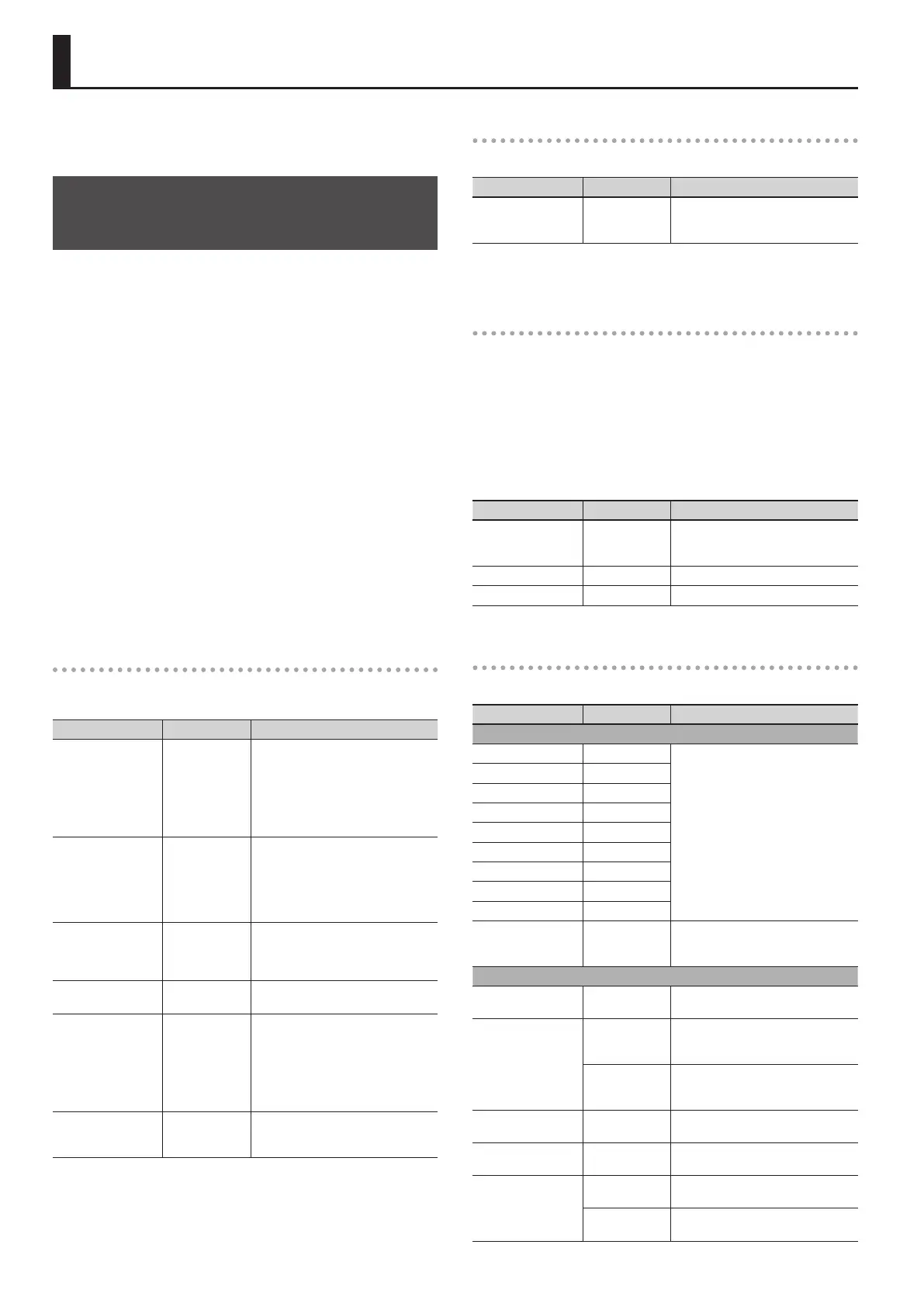88
For a list of all parameters download “JUPITER-50 Parameter Guide” (PDF le) from
“JUPITER-50” in the “Owner’s Manuals” list on the Roland website
(http;//www.roland.com/support/en/).
LIVE SET TONE MODIFY Screen
(SuperNATURAL Acoustic Tones)
Changes in dynamics
You can produce changes in dynamics that are idiomatic to each specic instrument,
shifting smoothly from subtle to powerful sounds in a natural way that goes beyond
a mere change in volume.
* Dynamics can be controlled by Note-on Velocity, the Modulation controller (CC01),
or Expression (CC11).
After playing a key, you can operate the Modulation controller (CC01) to continuously
control the dynamics (percussion instruments, struck-string instruments, and
plucked-string instruments are excepted).
Legato eect
With the exception of some sounds, legato playing (the technique of playing the
next key before releasing the previous key) lets you play notes that are smoothly
connected.
* To obtain a legato eect, set Mono/Poly to TONE or MONO.
Performance variation sounds
Musically appropriate performance variations are provided for each instrument,
and you can use control changes (CC80–CC83) to instantly switch between these
variations while you perform.
0001:Concert Grand–0009:Honky Tonk
Dierences in your playing strength will smoothly change the tone character in a
natural way.
Parameter Value Explanation
String Resonance 0–127
When the keys are pressed on an
acoustic piano, the strings for keys
that are already pressed also vibrate
sympathetically. The function used to
reproduce is called “String Resonance.”
Increasing the value will increase the
amount of eect.
Key O Resonance 0–127
This adjusts resonances such as the
key-o sound of an acoustic piano
(subtle sounds that are heard when you
release a key).
Higher values will increase the volume
of the resonances.
Hammer Noise -2– +2
This adjusts the sound of the hammer
striking the string of an acoustic piano.
Higher values will increase the sound of
the hammer striking the string.
Stereo Width 0–63
The higher the value set, the wider the
sound is spread out.
Nuance
TYPE1, TYPE2,
TYPE3
This changes the Tone’s subtle nuances
by altering the phase of the left and
right sounds.
This eect is dicult to hear when
headphones are used.
This has no eect for 0008:Concert
Mono.
Tone Character -5– +5
Higher values produce a harder sound;
lower values produce a more mellow
sound.
0010:Pure Vintage EP1–0025:Clav CA Combo
A key-o noise typical of that instrument will be heard when you release the key.
Parameter Value Explanation
Key O Noise (CC16) -64– +63
Adjusts the amount of key-o noise.
Higher settings will raise the volume.
This has no eect for 0012:Pure Wurly.
0026:Vibraphone, 0027:Marimba, 0078:APS
Vibraphone, 0079:APS Marimba
You can play a roll by operating the Modulation controller (CC01) while playing a
note.
You can produce a glissando eect by operating the pitch bend lever while holding
down a note, or by playing legato with the Portamento SW (CC65) turned on.
If Bend Range is set to Tone, you can produce a glissando eect by operating the
pitch bend lever.
If Bend Range is set to anything other than Tone, this eect will be obtained if Bend
Mode (CC19) is turned on. Use this when you want to switch between glissando
playing and conventional pitch change.
By using Mute (CC18) you can simulate the technique of using your hand or mallet to
mute the vibration (sound). It is eective to assign this to the D-BEAM controller.
Parameter Value Explanation
Mallet Hardness
(CC16)
-64– +63
Adjusts the hardness of the mallet.
Higher settings produce the sound of a
harder mallet.
Roll Speed (CC17) -64– +63 Adjusts the speed of the roll eect.
Variation Refer to p. 98 Performance variation sounds
0028:TW Organ
0028:TW Organ can be assigned only to layer 1 of the upper part or lower part.
Parameter Value Explanation
Harmonic Bar tab
Harmonic Bar 16' 0–8
Adjust the level of each footage.
A dierent harmonic component is
assigned to each footage; the sound of
the organ is created by mixing these
components.
The 8’ footage is the core of the sound;
this is the basic pitch around which the
sound is created.
Harmonic Bar 5-1/3' 0–8
Harmonic Bar 8' 0–8
Harmonic Bar 4' 0–8
Harmonic Bar 2-2/3' 0–8
Harmonic Bar 2' 0–8
Harmonic Bar 1-3/5' 0–8
Harmonic Bar 1-1/3' 0–8
Harmonic Bar 1' 0–8
Leakage Level 0–127
Level at which the signal of tonewheels
unrelated to the pressed keys is mixed
into the input
Percussion tab
Percussion Switch OFF, ON
If this is on, a crisp attack will be added
to the beginning of the notes.
Percussion Soft
NORM
The percussion sound will be at the
normal volume, and the sound of the
harmonic bars will be reduced.
SOFT
The percussion sound will be reduced,
and the harmonic bars will be at the
normal volume.
Percussion Soft Level 0–15
Volume of the percussion sound when
Percussion Soft is set to SOFT
Percussion Normal
Level
0–15
Volume of the percussion sound when
Percussion Soft is set to NORM
Percussion Slow
FAST
The percussion sound will disappear
immediately, producing a sharp attack.
SLOW
The percussion sound will disappear
slowly, producing a more gentle attack.
Parameter List

